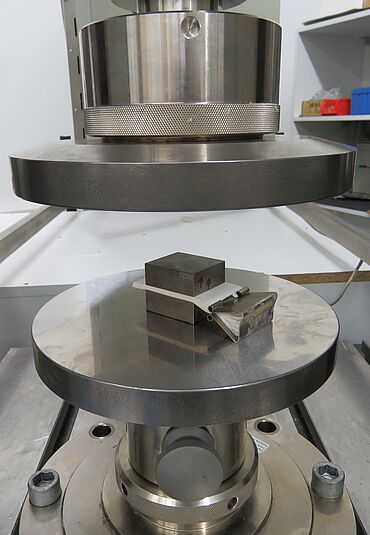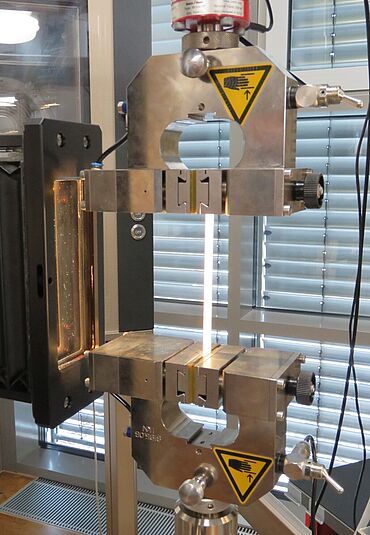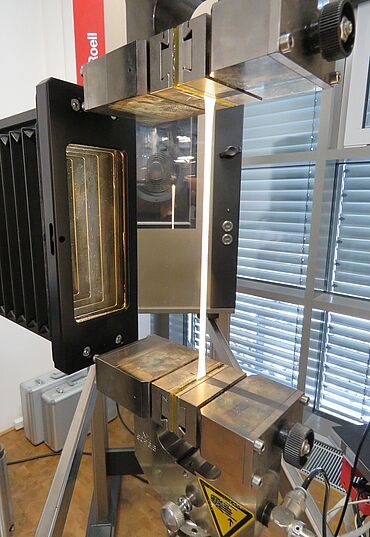Virtual Vehicle Research GmbH Optimizes Battery Safety with ZwickRoell
Case Study
- Customer: Virtual Vehicle Research GmbH
- Location: Graz, Austria
- Industry: Automotive
- Topic: Testing battery safety: mechanical characterization of battery cell components for the parameterization of finite element cell simulation models
July 2024
Virtual Vehicle Research GmbH uses ZwickRoell measurement technology to create parameters for FE cell simulation models that precisely describe the material behavior of cell components in the event of deformation. Practical use: these models are used to predict internal short circuits and thus increase battery safety. And the results of mechanical tests form the basis for the simulation of battery cells under crash loads.
Virtual Vehicle Research GmbH conducts research for the future of mobility
Virtual Vehicle Research GmbH is an international research and development center specializing in vehicle technology and mobility of the future. Founded in Graz (Austria), the company works with industrial partners, universities and research institutions to develop innovative technologies and methods. The focus is on the digitalization and virtualization of development processes, the safety and efficiency of vehicles and sustainable mobility.
The core competencies of Virtual Vehicle Research GmbH include the simulation and validation of vehicle components, the development of assistance systems and the optimization of powertrains. With its focus on interdisciplinary research and practical solutions, the company contributes significantly to the further development of the automotive industry and supports the transformation towards intelligent and environmentally friendly mobility concepts.

ZwickRoell top competencies in battery safety testing
- Production of reproducible test results for battery safety testing
- Precision and measurement accuracy of the testing machines
- Improvement in time efficiency
- Excellent project and partner communication
- Careful handling of battery components
- Innovative products and solutions
The task
Battery cells: mechanical component characterization under realistic conditions
Lithium-ion battery cells (LIBs) contain a liquid organic electrolyte that is toxic and flammable. This electrolyte enables the flow of ions between the electrodes and is therefore an essential component to ensure the functionality of LIBs. Electrolytes are essentially based on the conductive salt (usually lithium hexafluorophosphate), which is dissolved in various organic carbonates, such as ethylene carbonate (EC) or dimethyl carbonate (DMC).
In order to create a realistic environment for the materials to be tested, it was important for Virtual Vehicle Research GmbH to test the components in an electrolyte-wetted state. And in order to comply with the safety regulations in the testing laboratory, a replacement electrolyte was used for this purpose that does not require lithium hexafluorophosphate (LiPF6).
ZwickRoell's central task was to mechanically characterize all the individual components of the battery cell under realistic conditions. A major challenge was to grip the electrolyte-wetted specimens such as the separator, which is generally very thin (approx. 20 µm) and flexible. Above all, this required delicate handling and patience.
ZwickRoell solutions for battery safety testing
Tensile and compression tests for mechanical characterization
The first task was to produce suitable cell component specimens. ZwickRoell cut out rectangular separator specimens using a blanking tool. The focus was on the ceramic-coated separator. The reason for this is its key role in short-circuit prevention. The separator's task is to separate the electrodes from each other both electrically and spatially. The separator specimens were tested in a dry state on the one hand and in an electrolyte-soaked (“wet”) state on the other. Thanks to these tests, different failure behaviors of separators could be demonstrated.
The specimens for the compression tests consisted of a total of 100 individual layers stacked on top of each other. The reason for this procedure: this increases the measurement accuracy for the change in length in the test. A preload force was applied to close the gaps between the layers. To ensure the reproducibility of the results, a total of five tests were carried out per test configuration.
A ZwickRoell Z100 AllroundLine with an Xforce 100 kN load cell was the testing machine used. In the compression test, the displacement was measured using a crosshead displacement measuring system, taking into account the machine stiffness. A video extensometer was used for strain measurement in the tensile tests.
More information on battery testing with ZwickRoell

“The comprehensive and professionally prepared test report, which was submitted promptly together with the test data, deserves special mention. It reflects both the careful handling of the individual battery components and the high precision of the testing machines. Despite major challenges in handling individual very thin cell components in the electrolyte-wetted state, which mimics real environmental conditions, ZwickRoell's test engineers were able to generate reproducible and reliable test results.”
Dr. Patrick Kolm, Senior Researcher │ Battery Crash Safety
The result
Findings on the mechanical deformation behavior of separators
Tensile tests:
Figure 1 shows the influence of the tensile speed (10 mm/min, 100 mm/min and 500 mm/min) and the influence of the electrolyte on the separator specimens, which were tested in the transverse direction as an example. The “wet” tested separators were removed from a replacement electrolyte bath (mixture of diethylene carbonate and ethylene carbonate) immediately before testing. The test results show that the “wet” separator specimens have a higher stiffness than the “dry” specimens.
In general, it can be observed that the electrolyte-impregnated ceramic-coated separators exhibit greater stiffness when subjected to tensile stress. By coating the separator with Al2O3, the surface forms a rough and porous structure. One possible reason for the higher deformation resistance could be the interaction between the coating and the electrolyte, which is based on adhesion forces.
Compression tests:
Figure 2 shows the influence of the electrolyte on the mechanical deformation behavior of the separator stack. It shows the comparison of the force-travel curves of the separator stack previously soaked in a substitute electrolyte (mixture of diethylene carbonate and ethylene carbonate) and a “dry” stack. The test results show that the “wet” separator stack produces a significantly lower increase in force than the “dry” stack. In general, it can be observed that the electrolyte-impregnated separators exhibit lower stiffness under compression load. These findings confirm that a direction-dependent characterization is essential for a realistic parameterization of the separator in the cell simulation model.
Outlook:
The collaboration between Virtual Vehicle and ZwickRoell is currently being further intensified with regard to the mechanical characterization of cell components under compression load through the application of innovative test methods. As part of a scientific project, high-precision ZwickRoell measurement technology is to be used to characterize very thin (μm range) single-layer component specimens under compressive load in order to continuously improve the material data quality for the simulation.



